
Original Link: https://www.anandtech.com/show/2290
Memory based on the exciting new Micron Z9 memory chips for DDR3 first appeared a couple of weeks ago and we first looked at it in Super Talent & TEAM: DDR3-1600 is Here! As predicted in that review, it was only a matter of days until most of the major enthusiast memory makers began talking about their own products based on Micron Z9 chips. Some even announced fast availability of the new kits in the retail market.
The reasons for this are basic. All memory makers buy raw memory chips available in the open market. Some memory makers do not like to talk about the chips used in their DIMMs, as they consider that information proprietary, but this secrecy does not normally last very long. It is rare to see a memory manufacturer with a truly exclusive supply arrangement with a memory vendor, but several companies have been trying very hard to do just this, and we may see more of these attempts in the future.
The DIMM manufacturers then speed grade or "bin" the chips to create one or more speed grades from a single chip type. Memory chips are then surface-mounted on generic or proprietary circuit boards with SPD (Serial Presence Detect) chips programmed with generic code or custom SPD programming done by the DIMM maker. This is why the introduction of fast new chips like the Micron Z9 often circulates rapidly through the enthusiast memory market as each manufacturer tries to introduce products based on the new chips with new twists that outdo the competition. This does not mean the memory you buy from Super Talent, for example, is exactly the same as the Micron Z9-based memory you buy from Corsair. Companies pride themselves on the sophistication of their speed-grading technology, their design and/or sourcing of PCBs, and their skill at programming the SPD.
Despite the real differences that emerge in memory performance from different DIMM manufacturers, the normal arrangement is one company successfully uses a new chip in a top-performing new DIMM, and then everyone in the market has a similar memory product based on the same chip. That is why every memory company has announced, or will soon be announcing, their own Micron Z9-based memory.
One of the more interesting of the announcements is OCZ DDR3-1800, rated at 8-8-8 timings at DDR3-1800, which is the fastest production DDR3 kit currently available. This new PC3-14400 Platinum Edition kit is specified to reach DDR3-1800 at 1.9V and is claimed to have substantial headroom above this speed. It certainly appears that OCZ is binning Micron Z9 chips for even higher memory speeds, along with possibly some other tweaks to squeeze more from these chips. The test results should tell us what these new DIMMs can actually do.
OCZ PC3-14400 Platinum Edition
In the last several years, OCZ has developed a deserved reputation as a true innovator in the computer enthusiast market. They were the first of the memory companies to market high-end, high-quality power supplies, a product offering now available from other memory companies as well. OCZ cemented that relationship with the power supply market with their recent acquisition of PC Power and Cooling - a well-regarded player in the high-end PSU market. OCZ has also begun to market high-end video cards under their own brand name, something Crucial has done for several years.
In the end, if you're part of the computer enthusiast community, OCZ has been constantly introducing new and innovative products for that market, from ram cooling to CPU coolers to video cards to the very latest in memory technology. While most enthusiasts recognize OCZ as a memory company, many these days also recognize them for their power supplies, CPU coolers, or other products.
OCZ maintains an up-to-date website that provides specifics for their products. They are also represented on many forum sites, and they maintain dedicated forums for OCZ products on several websites. OCZ memory products come with a lifetime warranty.
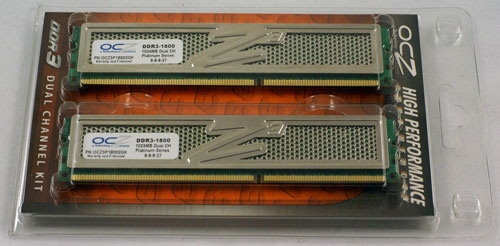
Like several other manufacturers, OCZ has moved to the smaller dual-channel clear clamshell package for memory kits. The card in the memory package is now a 4-page glossy instruction sheet with information on the features and installation of the memory.
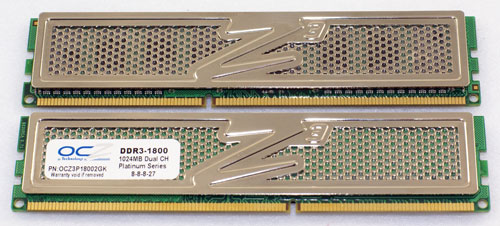
The DIMMs themselves are also easily recognized as OCZ with the large "Z" in the middle of the perforated XTC (Xtreme Thermal Convection) heatsink design. The XTC heatsinks are a familiar sight on high-end OCZ memory. OCZ tests and certifies the memory for DDR3-1800 8-8-8 performance on ASUS DDR3 boards. Like the other DDR3 DIMMs based on Micron Z9 memory, the OCZ DIMMs are single-sided 1GB parts. That means 2GB parts and 4GB kits are definitely a possibility in the future, when chip availability improves and the very high memory chip prices drop. Performance and timings would likely be somewhat below current specs in a 4GB kit.
| OCZ PC3-14400 Platinum Edition Memory Specifications |
|
| Number of DIMMs & Banks | 2 SS |
| DIMM Size | 1 GB |
| Total Memory | 2 GB (2 x 1GB) |
| Rated Timings | 8-8-8-27 at DDR3-1800 |
| Rated Voltage | 1.9V (Standard 1.5V) |
DDR3 is lower voltage, higher speed and slower timings than DDR2. The chart below was published in our introduction to DDR3 and summarizes some of the differences in the official JEDEC DDR2 and DDR3 specifications.
| JEDEC Memory Specifications | ||
| DDR2 | DDR3 | |
| Rated Speed | 400-800 Mbps | 800-1600 Mbps |
| Vdd/Vddq | 1.8V +/- 0.1V | 1.5V +/- 0.075V |
| Internal Banks | 4 | 8 |
| Termination | Limited | All DQ signals |
| Topology | Conventional T | Fly-by |
| Driver Control | OCD Calibration | Self Calibration with ZQ |
| Thermal Sensor | No | Yes (Optional) |
JEDEC specs a starting point for enthusiast memory companies. However, since there was never a JEDEC standard for memory faster than DDR-400 then DDR memory running at faster speeds is really overclocked DDR-400. Similarly DDR2 memory faster than DDR2-800 is actually overclocked DDR2-800 since there is currently no official JEDEC spec for DDR2-1066. DDR speeds ran to DDR-400, DDR2 has official specs from 400 to 800, and DDR3 will extend this from 800 to 1600 based on the current JEDEC specification.
The OCZ PC3-14400 is the first DDR3 we have tested with a rated 1800 MHz or higher speed. It also offers somewhat lower specified latencies of 8-8-8 at 1.9V. The OCZ DDR3-1800 is available as single 1GB DIMMs or a 2GB kit providing a matched pair of 1GB DIMMs.
Memory Test Configuration
This comparison of OCZ DDR3-1800 to other DDR3 memory uses a completely different test methodology than the earlier DDR3 reviews. Our reviews of DDR3 vs. DDR2, Intel P35 Memory Performance, Kingston DDR3, and Super Talent and TEAM DDR3-1600 were based on a Core 2 Duo 2.66GHz CPU with a common memory speed at 1066 and 1333 speeds. Since ratios were not available for higher speeds like 1600 and 2000 those speeds were achieved by overclocking the base system. This made comparing performance at the same processor speed, a standard procedure in our earlier DDR2 and DDR memory tests, all but impossible. The rapid ramping of DDR3 memory speeds coupled with the lack of ratios made those memory speed comparisons less useful.
New Test Methodology
Readers suggested a number of memory testing ratios and speeds which would allow a better comparison of memory performance. After considering the suggestions and the real ratios available the decision was made to settle on a new 3.0GHz test speed driven by a processor that could deliver multipliers to at least 9X and FSB speeds to 550+. This would allow DDR3-800, DDR3-1066, and DDR3-1333 to be tested at 3.0GHz at 9x333 settings. DDR3-1600 and DDR3-2000 would be tested at 3.0GHz at 6x500.
The requirement of a 9x or higher multiplier combined with the ability to run with stability at a 550+ FSB proved more difficult than anticipated. A very early Intel X6800 had unlocked multipliers but would not even boot above about 450 FSB. A very recent Q6700 met the 9X requirement but topped out in FSB at about 470 stable. Tests by other AnandTech editors confirmed that most quad core processors have a difficult time operating at 500 FSB, let alone the higher 550 requirements for overclocks above DDR3-2000. We finally located a recent X6800 that could do both the 9X multiplier and the 550 FSB requirements. This became our new processor for the memory test bed. Other components remained the same as the earlier DDR3 test bed.
It should be pointed out that the new test bed does use the same processor speed at all tested RAM speeds, but that different FSB speeds are used at low and high memory timings. Testing at the same processor speed does allow a better comparison of isolated memory performance, but it is not an exact apples-to-apples comparison. The variation in FSB speed at the same processor speed does affect the performance of the memory at the higher FSB speeds. This ranges from negligible in some tests to measurable in other benchmarks. For more information on the impact of FSB speed on performance you can refer to Intel P35 Memory Performance: A Closer Look.
A true apples-to-apples comparison of memory performance will only be possible when the additional ratios of 1600 and 2000 are available in the BIOS at a base 1333 memory speed. Still, while not perfect, the comparison of all memory speeds at 3.0GHz processor speed is much closer to our testing ideal than the previous test methodology.
All DDR3 Memory Retested
With the change in processor and base speed to 3.0GHz, all DDR3 memory was retested to provide data for comparison of all memory speeds at the same 3.0GHz processor speed. We have established high-performance DDR2 memory performance baselines and we will no longer be actively testing DDR2 memory performance for our DDR3 reviews. You can see the comparison of DDR2 and DDR3 on the next page, DDR2/DDR3 Overlap Speeds. Additional benchmarks were run to provide the most complete comparison at the common RAM speeds of 1066 and 800 MHz.
| Memory Performance Test Configuration | |
| Processor | Intel Core 2 Duo X6800 (x2, 2.93GHz unlocked, 4MB Unified Cache) 9x333 - 3.0 GHz 8x500 - 3.0 GHz |
| RAM | OCZ PC3-14400 Platinum (2GB kit - 2x1GB, DDR3-1800 8-8-8) Super Talent W1600UX2G7 (2GB kit - 2x1GB, DDR3-1600 7-7-7) Team TXD31924M1600HC9 (2GB kit - 2x1GB, DDR3-1600 9-9-9) Kingston KHX11000D3LLK2 (2GB kit - 2x1GB, DDR3-1333 7-7-7) Corsair CM3X1024-1066C7 (2GB Kit - 2x1GB- DDR3-1066 7-7-7) Corsair Dominator CM2X1024-8888C4 (2GB Kit - 2x1GB - DDR2-1250 5-5-5) |
| Hard Drive | Samsung 250GB SATA2 enabled (8MB Buffer) |
| System Platform Drivers | Intel - 8.3.0.1013 |
| Video Card | Leadtek WinFast 7950GT - 256MB |
| Video Drivers | NVIDIA 93.71 |
| CPU Cooling | Intel Retail HSF |
| Power Supply | Corsair HX620W |
| Motherboards | ASUS P5K3 Deluxe (Intel P35 DDR3) ASUS P5K Deluxe (Intel P35 DDR2) ASUS P5B Deluxe (Intel P965 DDR2) |
| BIOS Revision | 0604 (6/26/2007) |
| Operating System | Windows XP Professional SP2 |
Past performance tests of DDR2 memory on the Intel P965 and P35-DDR2 platforms are included for comparison. All current memory tests use the Intel P35-DDR3 test bed (ASUS P5K3 Deluxe) with the DDR3 memory under evaluation. As detailed on the results pages, overlap speeds were tested at 2.66GHz for compatibility with previous results. The DDR3 full performance pages include results at 3.0GHz, and also include a retest of the 1066 and 800 memory speeds at 3.0GHz CPU speeds.
The CPUs listed above in our table are 1066 FSB processors, but all ran fine at 1333 FSB at default multiplier and default voltage. New 1333 FSB processors with the same ratios may be substituted for these processors as soon as they are available, providing they meet the requirements of 9X or greater multiplier and stable operation at 550FSB..
DDR2/DDR3 Overlap Speeds
In Kingston Launches Low-Latency DDR3, memory performance was compared at the DDR2 and DDR3 overlap speeds of 800 and 1066 MHz. With the retesting of memory in the new test bed it was worthwhile to compare memory, at least in this initial review, at the overlap speeds. This presents the opportunity of seeing how top DDR3 performance compares to the DDR2 performance with which you are familiar.
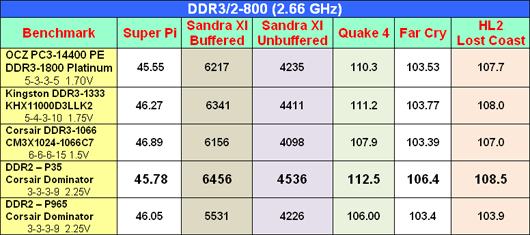 |
| Click to enlarge |
At 800 MHz, DDR2 is capable of 3-3-3 timings, while DDR3 is limited to CAS 5 in the ASUS P5K3 Deluxe BIOS. With that severe timing limitation, which is the result of the much higher speeds available with DDR3, the DDR2 memory is generally the fastest solution. The latest Elpida (Kingston) and Micron Z9 (OCZ) chips still beat the last generation DDR2 in the Intel P965 motherboard in almost every case. However, the latest P35 Intel chipset driving DDR2 instead of DDR3 is still the best performer at 800 MHz - simply due to the advantage of CAS 3 compared to CAS 5 timings.
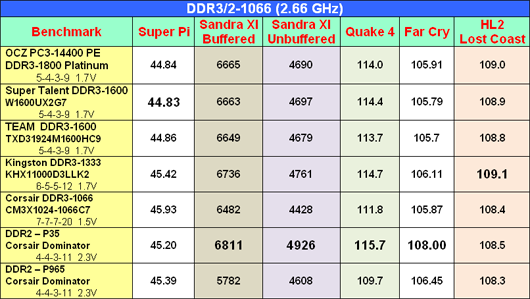 |
| Click to enlarge |
At the overlap speed of 1066 DDR2 still enjoys a timings advantage over DDR3 on the ASUS board. The fastest DDR3 CAS timings of 5 limits the best DDR3 timings to 5-4-3 compared to DDR2 at 4-4-3 with Corsair Dominator DDR2. Even with the timings advantage, DDR2 is only truly the better performer when running on the P35 chipset. The advantage for DDR2 here is very small to non-existent, however, as DDR3 results top a couple of the P35 DDR2-1066 benchmarks and the Elpida and Micron Z9 generally outperform DDR2/P965 across the board.
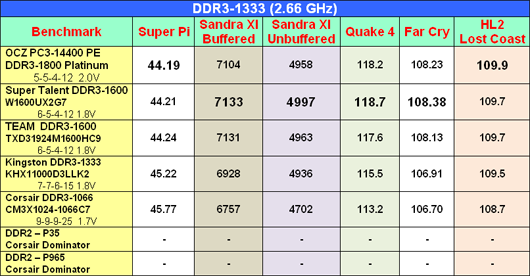 |
| Click to enlarge |
By 1333 the timing advantage for DDR2 is gone and DDR3 pulls clearly in the lead in all benchmarks. The Micron Z9-based memories top the 1333 performance charts in all benchmarks, and this is just the beginning of a range that extends to DDR3-2000 and beyond for some of these memories. Keep in mind that memory in these three charts are all running at the same 2.66GHz CPU speed, and that only the memory speed has been changed by varying ratios. It should be obvious in these results why Intel elected to move to the 1333 bus and the faster speeds of DDR3 memory.
Going up from DDR3-1333 to DDR3-1600, DDR3-2000 and beyond further extends the performance lead for DDR3 as you will see in the next three pages of DDR3 performance results on the same benchmarks. With the change to the 3.0GHz processor speed to allow memory tests through DDR3-2000 at the same CPU speed, all benchmarks were rerun at the 3.0GHz CPU speed with 800, 1066, and 1333 memory speeds. This allows a linear comparison of DDR3 memory at all available memory speeds while the CPU speed remains at a constant 3.0GHz.
For this and subsequent DDR3 reviews, DDR3 performance will be compared at 800, 1066, 1333, 1600, 2000, and the highest memory speed for the tested memory. 1000 is the logical base for the 333 strap, as is 1666, but current ratios limit realistic benchmarking to the 1066 and 1600 reference speeds. We will change to the 1000 and 1666 speed options as soon as available memory ratios in the BIOS allow a more convenient means to select 1000 and 1666 as memory speeds at a consistent processor speed. Those ratios are not currently available in the ASUS P5K3 Deluxe BIOS - or in any other DDR3 compatible motherboards at present.
Overclocking
We were more than surprised when Super Talent DDR3-1600 topped our overclock charts at DDR3-2008 in our last DDR3 memory review. The OCZ DDR3-1800 is based on a different binning of the same Micron Z9 memory chips, and it achieved an even faster overclock at a stable DDR3-2040.
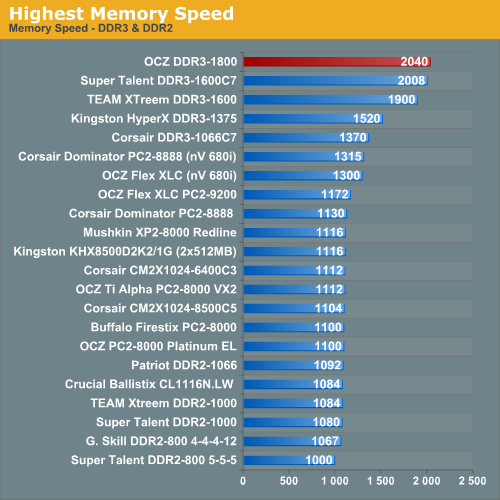
Perhaps even more significant were the timings that could be achieved at DDR3-2040. OCZ rates this memory at 8-8-8-27 timings at DDR3-1800. At 2040 the timings of 8-8-8-21 provided stable performance with 2.1V. This compares to the Super Talent, which is also based on Micron Z9, which required slightly slower 9-8-7-18 timings at 2.25V to achieve a stable DDR3-2008. The slightly better timings with the OCZ memory suggests that OCZ is using more aggressive speed binning for their new DDR3-1800 parts than others are using for their DDR3-1600 parts.
Advances in memory technology are rarely as dramatic as the speed and timing improvements we are seeing recently with Micron Z9 memory chips. For reference we included our ongoing overclocking chart results for DDR2 just so you can see how significant the new Micron Z9 memory really is. The highest DDR2 we have tested is Corsair memory at 1315 in an EVGA 680i motherboard. Early DDR3-1066 reached a bit higher as in the typical 1370 achieved with the launch Corsair DDR3-1066. Timings, however, were somewhat slow. Then the Kingston HyperX pushed 7-7-7 timings all the way to DDR3-1500. Now, less than 2 months later, state-of-the-art DDR3 is reaching DDR3-2000+ at aggressive timings. This kind of progress in memory technology makes the original JEDEC target of 800 to 1600 for DDR3 speeds appear far too limited.
Some end users consider 7-7-7 timings a benchmark with DDR3. We set those timings and pushed the OCZ as far as possible. The DDR3-1800 reached DDR3-1900 at 7-7-7-timings at 2.1V. This incredible speed at 7-7-7 eclipses previous results at 7-7-7 timings. The OCZ, Super Talent, and TEAM results are close at all comparable speeds, but the OCZ manages slightly better performance, slightly tighter timings, and a higher overclock than the other two Z9-based kits. OCZ is apparently binning to slightly tighter tolerances than the other two memories and that is showing in the performance improvements.
Super Pi
In Kingston Launches Low-Latency DDR3 memory performance was compared at 800, 1066, 1333, and highest memory speed. With the introduction of higher speed DDR3 we have added 1600 and 2000 to the standard comparison speeds, if the DDR3 memory is capable of reaching that speed.
To look at pure number crunching, Super Pi 1.5 was run in all memory test configurations. Super Pi is a very simple program as it merely calculates the value of Pi to a designated number of decimal positions. In this case we chose 2 million places.
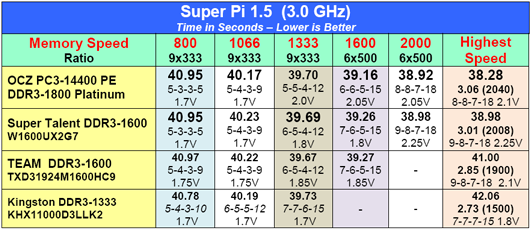 |
| Click to enlarge |
Super Pi is fastest (lower value for calc time) on the OCZ DDR3-1800 and Super Talent memory. Both these memories are based on the new Z9 Micron memory chips. At 1333, the Kingston is close behind, but it tops out at around 1500 speed, while the top Z9 memories go on to 2000 speed - shaving another 1.4 seconds off the Super Pi time at the same CPU speed. Lower latency DDR3 now passes DDR2, on either the P35 or P965 platforms, and extends to new performance levels. Any speed above 1066 is the domain of DDR3 and the higher speed delivers improved performance.
It is interesting that by 1333 the lower latency DDR3 has completely closed any gap that existed with the fastest timing DDR2, which can run as fast as 3-3-3 timings at moderate memory clocks. Lower latency DDR3 clearly demonstrates you will not have to give up a thing with DDR3 in the overlap speeds and you will gain higher speeds as well. The only current roadblock to DDR3 is the high price of admission.
Bandwidth and Memory Scaling
As you saw in the overclocking graph on page 5, the OCZ DDR3-1800 reached DDR3-2040. This is slightly higher than the Super Talent which reached DDR3-2008 and it is the highest memory speed we have yet reached with DDR3. To better understand memory performance at speeds from DDR3-800 to DDR3-2040 we compared standard or buffered bandwidth on the OCZ PC3-14400 at all standard speeds. The processor in each case was running at 3.0GHz as detailed in the memory test configuration on page 3. The OCZ bandwidth was compared to all DDR3 memory we have tested to date.
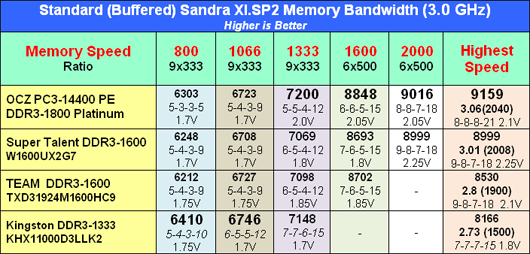 |
| Click to enlarge |
At DDR3-800 and 1066 the Elpida LL based Kingston is the best performer in the standard Sandra bandwidth test. However, at 1333 the lead shifts to the OCZ DDR3-1800 where it remains through the highest speed that could be reached with DDR3. It is interesting that the Elpida is very efficient in DDR2 overlap speeds but then loses steam at higher DDR3-only frequencies.
The new Z9 DDR3 memory owns the benchmarks from 1333 on. The Super Talent set new timing records and the OCZ extends that a bit further. The aggressive OCZ binning allows slightly faster timings at all speeds from 1333 to 2000+. In fact we were more than surprised that timings of 5-5-4-12 were stable with the OCZ PC3-14400 at 1333 speed. The Micron Z9 memory chips achieve high speeds and particularly tight timings on the OCZ memory. The TEAM memory is also based on Micron Z9 chips, and it competes well in the range it covers. Unfortunately, the binning on the TEAM has produced a memory that tops out about 100 MHz lower than the best Z9 DIMMs.
We also test memory with buffering schemes like MMX, SSE, SSE2, SSE3, etc, turned off. While these features do provide apparent improved bandwidth, the unbuffered bandwidth tends to correlate better with real-world gaming and application performance. Unbuffered performance does not always follow the patterns of buffered memory performance.
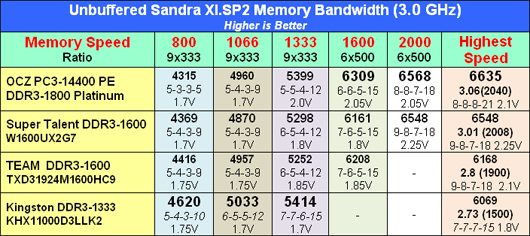 |
| Click to enlarge |
Unbuffered results show the same basic pattern as buffered results. At 800, 1066, and now 1333 speed the best unbuffered bandwidth is achieved with the Kingston LL memory. 1333 is neck and neck with the OCZ DDR3-1800 being reviewed. Above 1333 OCZ and other Micron Z9-based memory are the best performers. If you are looking for raw speed and performance it is increasingly clear that DIMMs based on Micron Z9 memory chips are the fastest DDR3 you can currently buy. There will still be variations based on the DIMM Manufacturers' experience and expertise in binning, PCB construction, and SPD programming.
Gaming
Three DX9 games representing different gaming engines were used to test the performance of the OCZ DDR3-1800 Platinum in real world gaming. There are more recent gaming titles available, but they are also DX9. We will update games in the memory test suite as soon as a selection of DX10 games with reliable benchmarks is available. At that time the memory test OS will also be moved to Vista.
The Far Cry - River demo was run for three loops and results in FPS were averaged over the three runs. ALL games were run at 1280x1024 resolution, which is the maximum resolution for the most common 19" flat panel monitors.
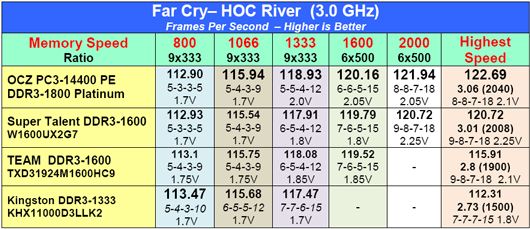 |
| Click to enlarge |
The Kingston tops performance at the slower DDR3-800 speed, but the Micron Z9-based memory takes top honors from 1066 to the Highest Speed DDR3. OCZ manages the best performance at those speeds with slightly faster timings than other Z9-based memory.
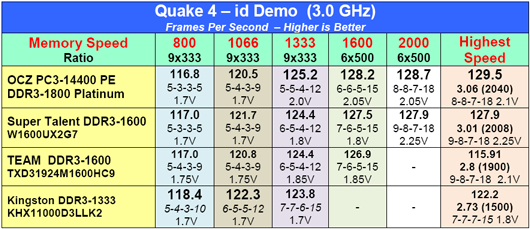 |
| Click to enlarge |
Quake 4 and the underlying engine have always proved to be very sensitive to improvements in memory bandwidth. This is amply demonstrated in these memory tests. Kingston, based on Elpida LL memory, performs best at the slower 800 and 1066 speeds, with OCZ and the other Z9 memory topping DDR-1333 to DDR3-2000. The pattern is basically the same as in Far Cry. With the constant CPU speed of 3.0GHz we see frame rates improve from 116.8 at DDR3-800 5-3-3 to 128.7 at DDR3-2000 9-8-7, an improvement of just over 10%. We have commented many times that memory is just one small part of the performance equation, but a 10% improvement in a game frame rate merely as the result of an increase in memory speed (and FSB speed, though we can't isolate that factor at present) is significant. Far Cry sees a similar increase from 112.90 at 800 to 121.94 at DDR3-2000, which is about an 8% improvement.
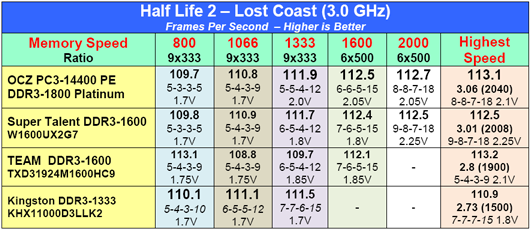 |
| Click to enlarge |
We include Half-Life 2: Lost Coast as a representative of games that are less sensitive to improvements in memory bandwidth. Lost Coast is played through the Steam engine, where there is the constant worry, for a reviewer, that each new update of Steam will break your test benchmarks. Though the differences are very subtle and HL2 performance is most influenced by the video card and CPU used in the benchmark, there are nonetheless patterns that are the same as the other two games. The Kingston wins by a small margin at 800 and 1066, while the OCZ tops the performance of Lost Coast from 1333 to 2000+. This game is not very sensitive to memory bandwidth so it is no real surprise that the performance improvement form 800 to 2000 is a small 3%.
Conclusion
When Kingston introduced the first real low-latency DDR3 we were impressed with the ability of the memory to reach DDR3-1500 at 7-7-7 timings at a reasonable low voltage. Many enthusiasts were also impressed with DDR3-1500 at 7-7-7 timings, as they should have been. However, some held out that it would take DDR3-1600 or DDR3-1666 that could run at 7-7-7 timings to get their attention.
A couple of weeks ago, Super Talent and TEAM introduced new DDR3 memory rated at DDR3-1600. In fact the Super Talent is actually rated at DDR3-1600 at 7-7-7 timings and it runs with complete stability at DDR3-1600 7-6-5 at 1.8V. The new Micron Z9 memory chips made this development possible, and we expected that every enthusiast memory maker would soon have DDR3 kits capable of DDR3-2000 and faster timings.
With the 1600 milestone, and the associated DDR3-2000 that memory could also reach, the reasons for not coveting DDR3 memory instead of DDR2 are officially gone. The fact is, DDR3 is faster than DDR2 today, and you won't have to wait a year to see that. Many manufacturers have announced super fast DDR3 based on these new Z9 Micron chips, and some of the offerings just sweeten the pot further.
OCZ PC3-14400 is such a memory. Rated at a blistering DDR3-1800 this is the fastest production DDR3 you can buy - at least for a few days. We have already heard a DDR3-1866 will be announced shortly. Perhaps more important than the rated speed is the fact the new OCZ memory promises an even more aggressive binning with the 1800 rating at 8-8-8 timings. The OCZ DDR3-1800 in fact handily exceeds it rated specs, reaching DDR3-2040 at the rated timings of 8-8-8 and an astounding DDR3-1900 at 7-7-7- timings at 2.1V. This is all evidence that, as we expected, OCZ managed a bit better binning for these DIMMs.
This OCZ PC3-14400 Platinum also proves that Micron Z9 chips can be very good at mid-range speeds. This is the first DDR3 memory we have tested that is completely stable at 5-5-4 timings at DDR3-1333, an achievement that sounded unlikely in early June when we were happy to be running DDR3-1333 at 9-9-9 timings. All in all the new OCZ DDR3-1800 is a very satisfying product, with a broad range of chart-topping, stable DDR3 performance that will keep any enthusiast happy for a while.
We had a conversation a few days ago with a memory industry Engineer where we were discussing the incredible development of DDR3 memory since it was first introduced just a couple of months ago. He commented that so much progress has been made in such short time that "I wonder what we can do next year for an encore?" We don't have an answer for that question, but we do think there is one majorstumbling block to DDR3 and that is the current astronomical price, a price that is two to three times higher than DDR2.
We understand the high price point for new technology, and that prices will inevitably drop. Indeed, there are only two real vendors for retail DDR3 memory right now: Elpida and Micron. However, several of the heavyweights like Samsung, Qimonda, and possibly Hynix are ready to launch their own DDR3 memory chips. Early word is these new entries will be very competitive with Micron Z9. If that is truly the case Enthusiast DDR3 memory prices will surely drop.
There are also the genuine performance improvements brought by DDR3 memory that can run twice as fast as DDR2. You won't get double the real-world performance with DDR3 running at twice the clocks of DDR2, but as you have seen in our testing here, an 8% to 10% improvement in real-world gaming is definitely possible. This will be reason enough for enthusiasts who value performance first to move quickly to DDR3 - and that will also lower prices over time.
We are genuinely pleased with all the new Micron Z9 memory products, and we are particularly pleased with the performance of this OCZ PC3-14400 Platinum Edition. We are confident you will also be pleased with the performance of this memory if you can find a way to handle the price. That matters a great deal for many buyers and not so much for others. If you can afford the price of admission you won't be disappointed. If you can't then buy cheap, fast DDR2 and put whatever you have saved into a faster CPU or an upgraded video card. Generally you will get more bang for your buck by putting money into those two areas.
On the other hand, if you already own the top video card and the top-performing CPU then DDR3-2000 memory will look like the next "must-have" product to squeeze another 8% or so performance out of your top-line build. Value buyers will never understand this, but for some enthusiasts the only thing that matters is having the best that is available.







